How and what to treat tomatoes in a greenhouse from late blight
Tomatoes of some varieties, especially of the old selection, are susceptible to fungal disease - late blight. The name of the disease in translation means "destroying plant", and it fully corresponds to this. If measures are not taken in time, the gardener risks losing the entire crop. It is easier to defeat the disease before it occurs, it is enough to follow simple watering rules and preventive measures - these operations will not allow the development of pathogenic mycelium in your area.
Before you start to fight the disease, you need to accurately determine it, so it is important to know the symptoms "in person."
A brief description and list of the first signs of damage
It is easy to detect the disease at an early stage, but it requires daily examination of the plants. The disease often affects tomatoes and potatoes, so it is not recommended to plant these crops in the garden, which were affected by late blight last season - or it will be required disinfect the soil before planting tomatoes.
Early detection of the signs of the disease will help to quickly and without loss cope with the terrible phenomenon. The infection is caused by a pathogenic mycelium, the spores of which are carried by birds. Disputes quickly spread across the site, and move to neighboring gardens and vegetable gardens.
First signs
Here are the early symptoms of the disease, after which it is necessary to immediately start processing the plants:
- Young leaves are covered with dark spots. It is they who need to be examined especially carefully.
- The petioles and base of the foliage are covered with a whitish bloom, and the outer side loses its color saturation. Gradually the color changes to brownish.
- Later the foliage dries up, early leaf fall begins.
- Experienced gardeners immediately after the rains examine the leaves - in case of defeat, they are covered with an oily coating of white.
- In the absence of help, the disease continues to spread and spreads to inflorescences. They suddenly turn yellow and then turn black and fall off.
- Spotting on tomatoes first appears from the inside, under the skin, and then comes out. The disease manifests itself in the lower part of the tomatoes and in a few days the dense ripe fruit becomes unsuitable for consumption and transportation.
- A neglected case - blackening and dying off of the stems begins. Sometimes whitish ones appear on black spots. Such plaque is especially manifested in a rainy season or in a greenhouse with an insufficient ventilation system.
At an early stage, plants and crops can still be saved, traditional medicine often helps. Launched plants will need to be treated with contact or systemic fungicides. If the plants are left without help, the crop and the entire plant will die.
Factors affecting the development of the disease
Conditions under which late blight receives an impetus for rapid development:
- the neighborhood of plantings of potatoes and tomatoes;
- heavy heavy rains, longer than 3 days - it is necessary to prepare a solution for preventive spraying;
- changes in the average daily temperature. Tomatoes require additional protection at daily surges of 8-12 ° C;
- when grown in open ground with frequent and strong fogs, it will be necessary to treat plants against late blight;
- thickened planting - plants lack light and are poorly ventilated. This is especially true for tall varieties with a dense crown when grown in greenhouses;
- excessive application of organic matter.
Important
It is important for a gardener to remember one rule - in a dry season, it is not necessary to be afraid of late blight, and in wet weather, it will be necessary to perform the whole range of agrotechnical measures.
Cure technique
Among fungicides, gardeners rated 4 drugs the most in terms of price-quality ratio.
"Hom" - contact fungicide containing copper oxychloride. It is recommended to spray the plants with the drug at least 3 times per season, with a break. Processing is stopped 20 days before harvesting ripe tomatoes. The duration of the protective properties is 14 days. The solution is prepared according to the instructions: 40 mg per bucket of water. The drug does not retain its properties for a long time, therefore, processing should be carried out immediately after dilution.
"Furacilin" - antibacterial drug, the solution is stored for a long period. After crushing 10 tablets, the powder is dissolved in a bucket of water. Treatments are carried out according to a certain scheme:
- Before flowering.
- When an ovary forms on the bushes.
- The beginning of the ripening of tomatoes.
Fitosporin - bactericidal substance, harmless to human health. Contains bacteria that feed on spores. The active substance penetrates into the material of the plant parts and protects it throughout the season. 2 tsp the drug is dissolved in a bucket of warm settled water and set aside for a short period of time to activate bacteria. It is recommended to spray the plant after long rains.
"Metronidazole" and "Trichopol" Are antibiotics with antibacterial and antimicrobial properties. The frequency of treatments is every 10 days or during high humidity.
Compositions of traditional medicine
Infusion of chives. It is prepared according to the scheme:
- Chop 200 g of garlic.
- Pour 200 mg of water and leave for 24 hours.
- Filter the mixture, squeeze the gruel. The volume of the solution is brought to 10 liters by adding only warm water.
- Add 1 g of potassium permanganate and 30 g of crushed laundry or tar soap to the solution.
A solution of kefir, milk or whey for tomatoes. For the preparation, mix serum and warm water in the same proportion. The composition is regularly treated with tomatoes at intervals of 10 days.
Saline solution. The product is used to protect young plants at an early stage of infection. The drug leaves a protective film on the surface of the foliage that prevents the spread of the disease. 1 glass of common coarse salt is dissolved in a bucket of water and treated with affected and healthy plants.
Preventive actions
When growing tomatoes in different conditions, the gardener needs to take a number of agrotechnical measures. Let us analyze in detail the preventive measures when growing vegetables in open ground.
Open ground is difficult conditions in which plants are more susceptible to disease or pests. Preventive measures:
- Correct watering: adult bushes are recommended to water once a week.
- Planting tomato varieties that can fight pests or diseases. Thanks to the activities of domestic breeders, the production of seed material of new varieties resistant to late blight has been established.
- Growing varieties of ultra-early ripening. Such plants begin to ripen before the peak of disease activity.
- Compliance with the rules of crop rotation of garden crops. If necessary, the soil in the infected areas must be completely replaced or disinfected with special preparations.
- Disinfection of seeds. Before planting, the material must be pre-treated with a weak solution of potassium permanganate, and after drying - with a nutrient solution prepared according to the recipe: 0.5 liters. water 1 tbsp. l. wood ash, copper sulfate on the tip of a knife, boric acid, mix, let cool, soak the seeds for 24 hours. The disinfected seeds are ready for planting, they sprout quickly and amicably and are protected from late blight.
- Normalization of soil composition and deep digging in autumn.Such a simple operation will cause the death of the wintering mycelium.
- Correct fit. It is not recommended to thicken the bushes and tomato beds, this impairs the ventilation of the plants and increases the humidity, and this is the main cause of the disease.
- Mulching. The soil under the bushes is covered with a layer of sawdust or other mulch, and after each watering and loosening of the earth, the layer is renewed.
- Preventive sprays. When the first tomatoes appear in the brushes, the fruits are treated with saline. For early prevention, you can use kefir, whey or garlic infusion. After prolonged rainfall or in wet foggy weather, it is necessary to carry out a preventive treatment with a contact fungicide.
When growing tomatoes in greenhouse conditions, the same prevention methods are used as under the sky. But in an enclosed space, you will need to take responsibility for airing the greenhouse and maintaining a comfortable temperature for tomatoes.
Regardless of what is chosen for the treatment of late blight, be it brilliant green or Homa solution, the main thing is to start processing at the first signs of pathogenic spores in the garden. It is important for gardeners to remember one of the basic rules - it is easier to prevent the spread of diseases and pests using simple plant care operations. Therefore, it is necessary to constantly monitor the condition of the tomato foliage. In this simple way, gardeners can reliably protect tomatoes from late blight.
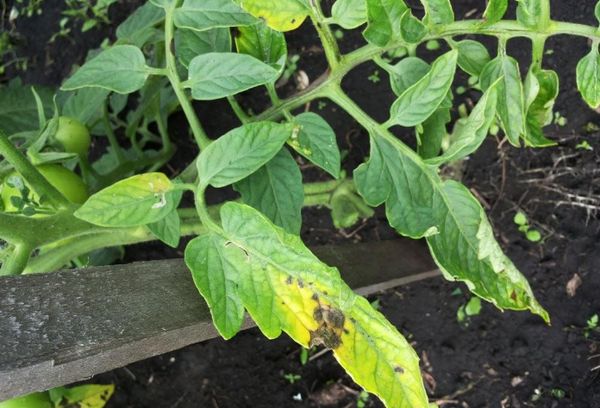
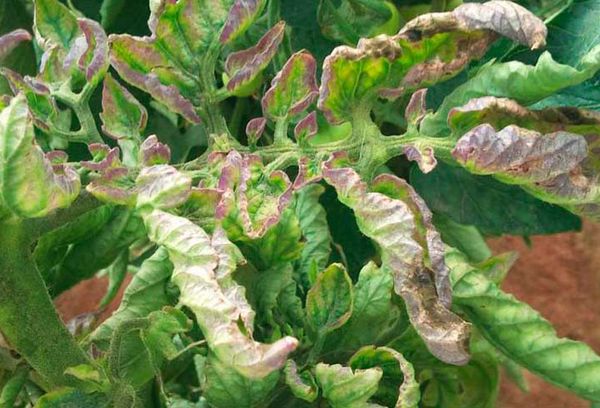

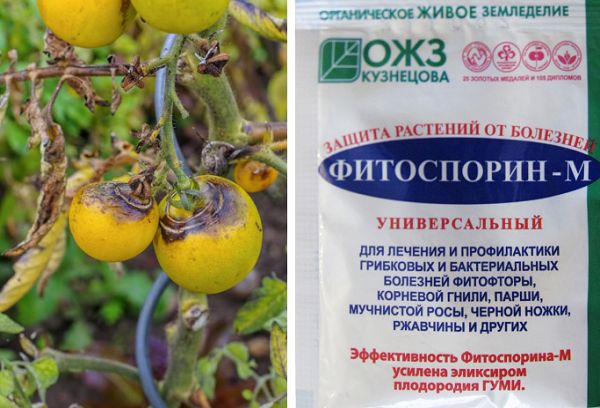
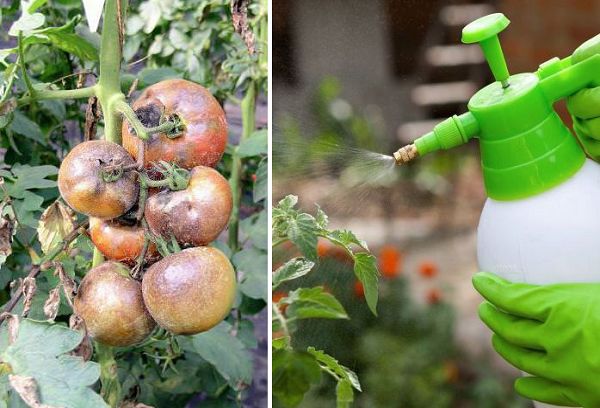
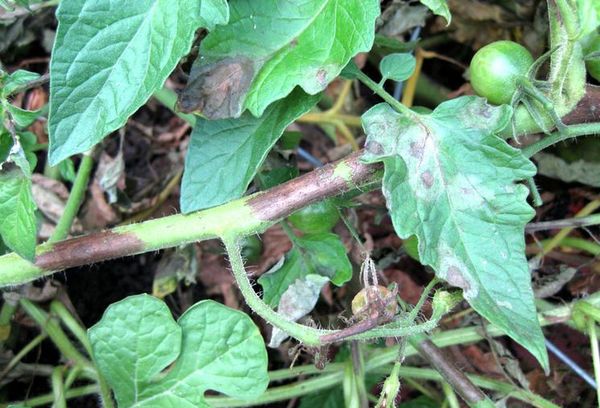
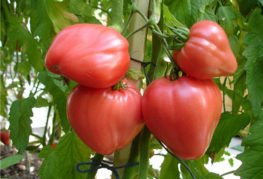
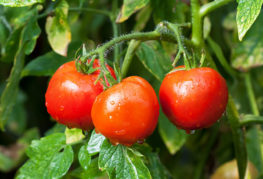
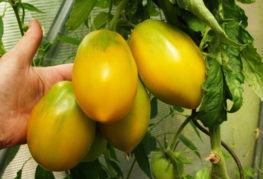
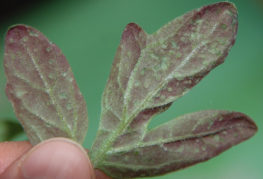
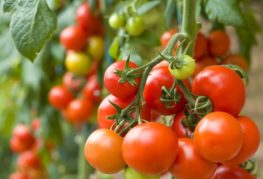

and will be published shortly.